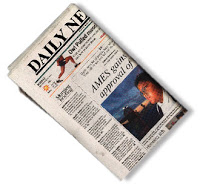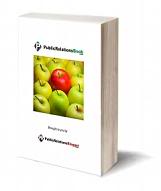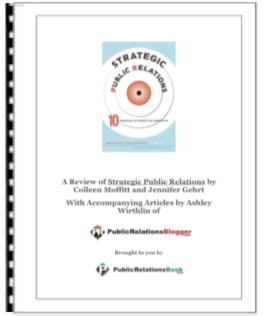________________________________________________________________________
 It’s safe to say that we live in interesting times. It seems we hardly have a breather between wars, tragedies, scandals, epidemics, circus trials and other events that capitalize the media’s attention. For the business seeking publicity, the "news hole" for more traditional stories -- new product reviews, business features, offbeat promotions -- keeps shrinking as the "big story" mentality takes hold.
It’s safe to say that we live in interesting times. It seems we hardly have a breather between wars, tragedies, scandals, epidemics, circus trials and other events that capitalize the media’s attention. For the business seeking publicity, the "news hole" for more traditional stories -- new product reviews, business features, offbeat promotions -- keeps shrinking as the "big story" mentality takes hold.
Fortunately, you’re not completely at the mercy of world events when it comes to obtaining some exposure. By being smart and aggressive, you can find a way to break through the logjam by tying-in -- where appropriate and tasteful -- with the news of the day.
Here are a few good examples (including a couple in which I was personally involved):
Taco Bell’s Mir Brainstorm. The Soviet Mir space station was falling, and Taco Bell reaped the benefits. The company set up a 40’ x 40’ vinyl target -- emblazoned with the company's logo and the words ''Free Taco Here!'' -- 10 miles off the coast of Australia. In the extremely unlikely event that Mir hit the target, the company promised free tacos to all 281 million Americans. Space-travel experts said the prospects of the debris hitting the mark were slim to none. Taco Bell added relevance to the public relations stunt by claiming to have taken out an insurance policy. A minute-by-minute countdown of Mir's descent and a photo of the floating target were anxiously seen by millions of hungry websurfers on the Taco Bell site. The result? Millions of dollars of free publicity on major news programs and media outlets around the world. Their website could hardly handle the traffic.
5 Star Shine Goes to War. Fellow Free Publicity subscriber Glenn Canady discovered that his car polishing product -- 5 Star Shine -- was being used by the U.S. Navy to keep the Aegis radar equipment up and running in the face of saltwater, sea air and other potentially damaging elements. Take a look at Glenn’s press release -- along with a great hit he earned in the San Diego Union Tribune--by going to: http://www.5starshine.com/press-coverage.html
Dan’s Lucky Angel. We were charged with getting publicity for the "My Little Angel" doll, so we sent one to a photographer in Ireland, who took a shot of the doll "kissing" the lucky Blarney Stone. We then sent the newly-lucky doll on to Olympic speedskater Dan Jansen at Lillehammer. When the previously hard-luck skater finally won his elusive gold medal, we took the credit -- and got lots of press!
Here’s how to tie-in with a news event:
1. Be prepared. If something happens that can offer the possibility of your involvement, you’ll need to act quickly. Make sure you have press materials prepared beforehand so they’re ready to go when needed. Obviously, you can’t predict news events, but you can begin examining your product, service or area of expertise to discover the types of events that may occur and the role you can play. Put together a strong bio that details your background and expertise. Make a list of the news editors, assignment editors and producers at, respectively, your local newspaper, TV stations and talk radio stations.
2. Be appropriate. This means two things, actually. First, don’t force a fit where none exists. If the world is focused on, say, a manned mission to Mars, your carpet cleaning business probably has nothing much that it can do to tie-in. There has to be some legitimate connection, or else you’ll be laughed out of the newsroom (on the other hand, if it’s proved that the germs behind some fast-spreading respiratory illness can live in carpeting, you’re just the person to talk to the press about how to kill germs hiding in carpets). The second measure of what’s appropriate is common sense and decency. Jumping on a tragedy with a hype-filled press release is just plain ghoulish. In the aftermath of something truly awful, go to the press only if you have something unique, helpful, non-promotional and newsworthy to offer.
3. Be timely. If you have something of immediate value to offer (e.g. you’ve written a book about a major figure who’s just died), time is of the essence. Work from the media list you’ve already prepared and hit the phones. Tell the reporters, editors and producers who you are and the kinds of insight you can offer about the current situation. Since seconds count, offer to stop by with a copy of your book, or to email or fax your press materials. If you really are an expert on the subject of the breaking news story, you’re doing the journalist a huge favor right now, so don’t be shy.
4. Be timely, part 2. The other side of the coin: You have a story that might fit in with what’s happening, but it’s lighter, softer and less timely (5 Star Shine is a great example. It fits with world events, but it’s not hard news). In these cases, wait until the dust has settled. The first few days covering any big story, the media is interested solely in the hard stuff. The who, what , when , where and why info. If you can help with that, great. If not, hang on until the media machine needs more fuel. After a little while, there will be huge blocks of time to fill, breaking news will dissipate and the media will begin turning to lighter stuff to fill the void. Consider that, just in the past few weeks, you’ve begun hearing about such things as the "Talking Iraqi Information Minister Doll". Expect much more to come.
5. Be creative. For non-tragic events, taking a fun approach often works wonders. Consider the Mir idea (it was already determined the station would land in the water, so there was no element of potential tragedy involved. If there was a chance that people could have gotten hurt, the promotion wouldn’t have been such a great notion). Or think about how ice cream companies that get mileage out of naming flavors for newsmakers, or fashion designers who send out lists of fashion hits and misses for major Hollywood events or DJ’s who do things like sleeping in a billboard until the hometown team breaks its losing streak. When there no lives at stake and the story is purely for fun, be as creative and "out there" as you can to tie in.
6. Be smart. One very important caveat has to be mentioned: unless you specifically cater to a particular audience -- all of whom are in agreement a particular issue -- don’t take sides politically. No matter how strongly you may feel about a certain issue, if a segment of your potential or existing customer base may feel differently, you’re taking a major gamble by choosing sides. If you want to poke fun at politicians, include both Democrats and Republicans. Unless your area of expertise requires it, steer clear of divisive issues such as religion, abortion, gay rights, etc. Using your business as a personal political soapbox can come back to haunt you. This isn’t about "wimping out", it’s common business sense. Customers are hard enough to attract and keep -- there’s no point in going out of your way to alienate them by showing disdain for their beliefs.
Bill Stoller, the "Publicity Insider", has spent two decades as one of America's top publicists. Now, through his website, eZine and subscription newsletter, Free Publicity: The Newsletter for PR-Hungry Businesses, he's sharing -- for the very first time -- his secrets of scoring big publicity. For free articles, killer publicity tips and much, much more, visit Bill's exclusive new site.
Article Source.
Tags: gaining publicity, using other news as publicity, public relations, PR
|

Tips for Gaining Publicity from News Events
________________________________________
 It’s safe to say that we live in interesting times. It seems we hardly have a breather between wars, tragedies, scandals, epidemics, circus trials and other events that capitalize the media’s attention. For the business seeking publicity, the "news hole" for more traditional stories -- new product reviews, business features, offbeat promotions -- keeps shrinking as the "big story" mentality takes hold.
It’s safe to say that we live in interesting times. It seems we hardly have a breather between wars, tragedies, scandals, epidemics, circus trials and other events that capitalize the media’s attention. For the business seeking publicity, the "news hole" for more traditional stories -- new product reviews, business features, offbeat promotions -- keeps shrinking as the "big story" mentality takes hold.Fortunately, you’re not completely at the mercy of world events when it comes to obtaining some exposure. By being smart and aggressive, you can find a way to break through the logjam by tying-in -- where appropriate and tasteful -- with the news of the day.
Here are a few good examples (including a couple in which I was personally involved):
Taco Bell’s Mir Brainstorm. The Soviet Mir space station was falling, and Taco Bell reaped the benefits. The company set up a 40’ x 40’ vinyl target -- emblazoned with the company's logo and the words ''Free Taco Here!'' -- 10 miles off the coast of Australia. In the extremely unlikely event that Mir hit the target, the company promised free tacos to all 281 million Americans. Space-travel experts said the prospects of the debris hitting the mark were slim to none. Taco Bell added relevance to the public relations stunt by claiming to have taken out an insurance policy. A minute-by-minute countdown of Mir's descent and a photo of the floating target were anxiously seen by millions of hungry websurfers on the Taco Bell site. The result? Millions of dollars of free publicity on major news programs and media outlets around the world. Their website could hardly handle the traffic.
5 Star Shine Goes to War. Fellow Free Publicity subscriber Glenn Canady discovered that his car polishing product -- 5 Star Shine -- was being used by the U.S. Navy to keep the Aegis radar equipment up and running in the face of saltwater, sea air and other potentially damaging elements. Take a look at Glenn’s press release -- along with a great hit he earned in the San Diego Union Tribune--by going to: http://www.5starshine.com/press-coverage.html
Dan’s Lucky Angel. We were charged with getting publicity for the "My Little Angel" doll, so we sent one to a photographer in Ireland, who took a shot of the doll "kissing" the lucky Blarney Stone. We then sent the newly-lucky doll on to Olympic speedskater Dan Jansen at Lillehammer. When the previously hard-luck skater finally won his elusive gold medal, we took the credit -- and got lots of press!
Here’s how to tie-in with a news event:
1. Be prepared. If something happens that can offer the possibility of your involvement, you’ll need to act quickly. Make sure you have press materials prepared beforehand so they’re ready to go when needed. Obviously, you can’t predict news events, but you can begin examining your product, service or area of expertise to discover the types of events that may occur and the role you can play. Put together a strong bio that details your background and expertise. Make a list of the news editors, assignment editors and producers at, respectively, your local newspaper, TV stations and talk radio stations.
2. Be appropriate. This means two things, actually. First, don’t force a fit where none exists. If the world is focused on, say, a manned mission to Mars, your carpet cleaning business probably has nothing much that it can do to tie-in. There has to be some legitimate connection, or else you’ll be laughed out of the newsroom (on the other hand, if it’s proved that the germs behind some fast-spreading respiratory illness can live in carpeting, you’re just the person to talk to the press about how to kill germs hiding in carpets). The second measure of what’s appropriate is common sense and decency. Jumping on a tragedy with a hype-filled press release is just plain ghoulish. In the aftermath of something truly awful, go to the press only if you have something unique, helpful, non-promotional and newsworthy to offer.
3. Be timely. If you have something of immediate value to offer (e.g. you’ve written a book about a major figure who’s just died), time is of the essence. Work from the media list you’ve already prepared and hit the phones. Tell the reporters, editors and producers who you are and the kinds of insight you can offer about the current situation. Since seconds count, offer to stop by with a copy of your book, or to email or fax your press materials. If you really are an expert on the subject of the breaking news story, you’re doing the journalist a huge favor right now, so don’t be shy.
4. Be timely, part 2. The other side of the coin: You have a story that might fit in with what’s happening, but it’s lighter, softer and less timely (5 Star Shine is a great example. It fits with world events, but it’s not hard news). In these cases, wait until the dust has settled. The first few days covering any big story, the media is interested solely in the hard stuff. The who, what , when , where and why info. If you can help with that, great. If not, hang on until the media machine needs more fuel. After a little while, there will be huge blocks of time to fill, breaking news will dissipate and the media will begin turning to lighter stuff to fill the void. Consider that, just in the past few weeks, you’ve begun hearing about such things as the "Talking Iraqi Information Minister Doll". Expect much more to come.
5. Be creative. For non-tragic events, taking a fun approach often works wonders. Consider the Mir idea (it was already determined the station would land in the water, so there was no element of potential tragedy involved. If there was a chance that people could have gotten hurt, the promotion wouldn’t have been such a great notion). Or think about how ice cream companies that get mileage out of naming flavors for newsmakers, or fashion designers who send out lists of fashion hits and misses for major Hollywood events or DJ’s who do things like sleeping in a billboard until the hometown team breaks its losing streak. When there no lives at stake and the story is purely for fun, be as creative and "out there" as you can to tie in.
6. Be smart. One very important caveat has to be mentioned: unless you specifically cater to a particular audience -- all of whom are in agreement a particular issue -- don’t take sides politically. No matter how strongly you may feel about a certain issue, if a segment of your potential or existing customer base may feel differently, you’re taking a major gamble by choosing sides. If you want to poke fun at politicians, include both Democrats and Republicans. Unless your area of expertise requires it, steer clear of divisive issues such as religion, abortion, gay rights, etc. Using your business as a personal political soapbox can come back to haunt you. This isn’t about "wimping out", it’s common business sense. Customers are hard enough to attract and keep -- there’s no point in going out of your way to alienate them by showing disdain for their beliefs.
Bill Stoller, the "Publicity Insider", has spent two decades as one of America's top publicists. Now, through his website, eZine and subscription newsletter, Free Publicity: The Newsletter for PR-Hungry Businesses, he's sharing -- for the very first time -- his secrets of scoring big publicity. For free articles, killer publicity tips and much, much more, visit Bill's exclusive new site.
Article Source.
Tags: gaining publicity, using other news as publicity, public relations, PR
|
| What did you think? |
Filed Under:
gaining publicity,
PR,
public relations,
using other news as publicity
Subscribe to:
Post Comments (Atom)






Comments (0)
Post a Comment